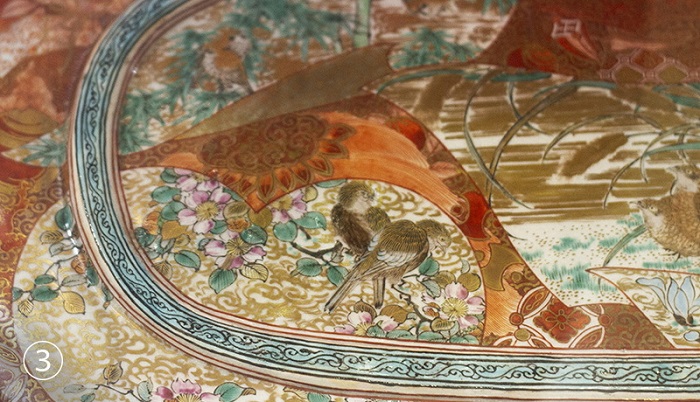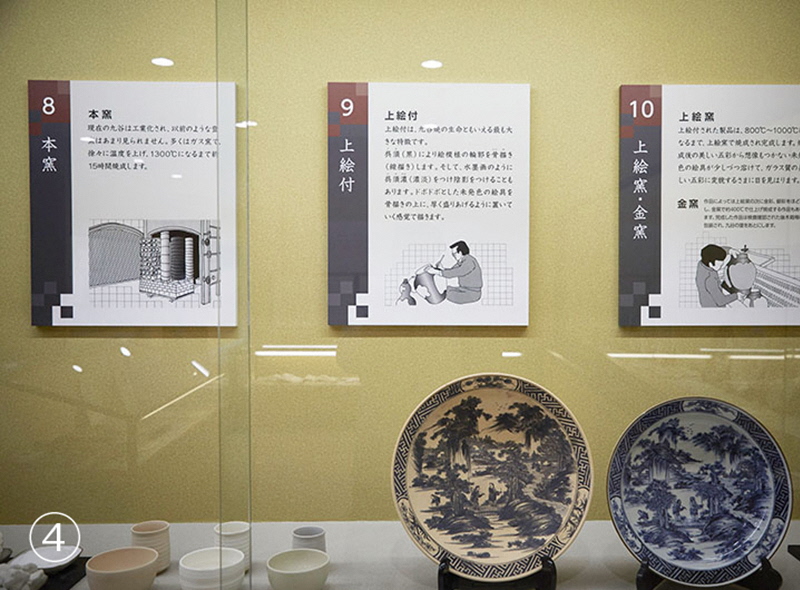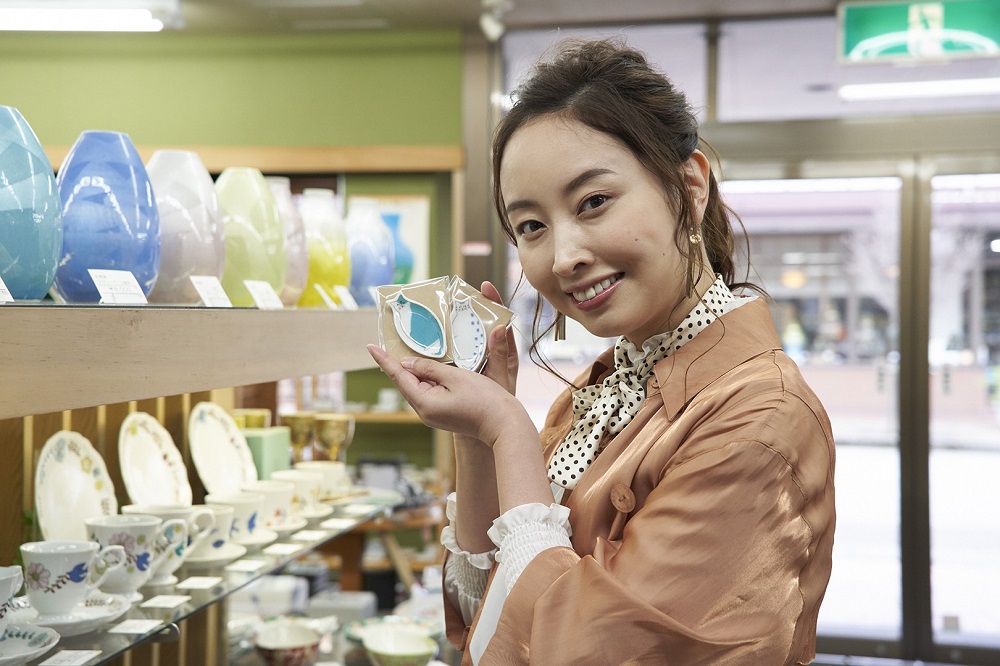A visit at the Kutani Pottery Village
登録日:2020年3月31日
This is the content at the time of the interview.

at the Kutani Pottery Village Monument (photographed November 27, 2019)
Since the late Edo period to the present day, Nomi City has been a major producer of the representative colored porcelain, Kutani Chinaware. The Nomi City Kutani Ceramics Museum is a place to learn about the history and manufacturing method of Kutani ceramics, the Asakura Isokichi Museum (Nomi Kutani Ceramics Museum) displays the works of Isokichi Asakura who in 1996 was the first to receive the Order of Culture, the Kutani Ceramics Center provides pottery making experiences for all, the Kutani Ceramics Craftsmen Workshops cultivate artists in Nomi City, and shops specializing in Kutani ceramics are all gathered here in this ceramic arts village base.
First, let us take a look at the Nomi City Kutani Ceramics Museum.
The Nomi City Kutani Ceramics Museum opened in 1982 to look back on the history of Kutani ceramics, appreciate past masterpieces, and to display a new breath of contemporary Kutani for the general public. It was renewed and opened again in 2018. With “Hospitality Museum” as its concept, every effort in renovation was made to meet the demands of the times, such as enhancing the permanent exhibits, creating a barrier-free environment, and internationalization preparations to welcome many visitors. The building is composed of five rooms (exhibit rooms) with walls of navy blue, red, purple, green, and yellow. In the Kaga region, colored walls were used in the Edo period for special rooms to welcome nobles and guests. There is a tradition that has been used in the "hospitality" space, such as with the buildings of the Maeda family of the Kaga domain and the historic teahouses. The “spirit of hospitality” is in the idea of spending a colorful winter in Hokuriku Kaga, which is filled with heavy colorless snow. In addition to the permanent exhibitions of masterpieces from the Edo era in the "Navy Blue Room" and the "Red Room," special exhibitions are occasionally held in the "Purple Room" and "Green Room," and the "Yellow Room" is equipped with details on the production process of Kutani ceramics, video screenings, and reading material related to Kutani ceramics.

Nomi City Kutani Ceramics Museum
First, let us go to the “Navy Blue Room” (Konjo-no-ma). Permanent exhibitions of masterpieces from the Edo era mainly of five-colored and blue-colored Kutani ceramics are on display. Several masterpieces line the room, including "Yousaitsubo," a work by the living national treasure, Yasukichi Tokuda III.




1) Flat dyed color bird and flower bowl You Wakasugi Late Edo Period 2) Large Hydrangea Pot Yayou Yoshida Late Edo Period 3) Yasokichi Tokuda III “Yousaitsubo”
The adjacent "Red Room" is an exhibition focused on red paintings. Kutani ceramics had the highest trading value in Japan as export porcelain through Japonism that prospered throughout Europe and the United States since the Meiji era, and it was called "Japan Kutani" as the representative porcelain of the nation. There were Kutani ceramic stores in Paris at that time. Many of the works from that period are also exhibited in this "Red Room," and the "Akae Kacho Jinbutsuzu Otsubo Ittsui" completed by a reproduction project to convey its high technological capabilities to future generations is also exhibited. It is amazing to think that a large urn that is one meter high, was shipped from Yokohama and Kobe ports to various areas of Europe and America.


Akae Kacho Jinbutsuzu Otsubo (partial)

Many items exported during the Meiji ear are on display at the museum.
Among the many works, the masterpiece is the work of Shoza Kutani. Born in a farmhouse in the current Terai-machi of Nomi City, he learned the basics of pottery at the age of 10, learning skills in many workshops, while building kilns in various parts of the clan to teach and became independent at the age of 25. He returned to his hometown and opened the kiln. Shoza was extremely enthusiastic about researching clay and pigments in addition to ceramics, and improved red-painting techniques, which were popular at the time, and he was the first to adopt Western paint imported into Japan from the late Edo period through the early Meiji period. He succeeded in painting with intermediate colors that could not be expressed solely with pigment glaze. In other words, it was Shoza's achievement that completed the gorgeous "colored gold brocade" technique in which red painting was painted with gold with the addition of Western paint, and the delicate drawings and various paintings swayed the Kutani pottery world at the time. It is said that the number of disciples who were taught exceeded 300. This tendency of painting was accepted as an export trade product during the first half of the Meiji era, and it became a major part of the Kutani ceramic style.



1) Shoza Kutani flower decoration plate 2 ) Shoza Kutani flower decoration plate (partial) 3) Shoza Kutani flower decoration plate (bottom part)


In addition, special exhibitions, individual exhibitions, and group exhibitions are held in the "Green Room" and "Purple Room." Upstairs on the second floor, you will find the "Yellow Room" where a deeper knowledge of the detailed production process of Kutani ceramics is gained through the permanent exhibitions and browsing specialized literature and video screenings.

Nomi City Kutani Ceramic Museum Director, Mr. Nakaya and Facility Director, Mr. Sakuma
In addition, special exhibitions, individual exhibitions, and group exhibitions are held in the "Green Room" and "Purple Room." Upstairs on the second floor, you will find the "Yellow Room" where a deeper knowledge of the detailed production process of Kutani ceramics is gained through the permanent exhibitions and browsing specialized literature and video screenings.




1) Green Room 2) Purple Room 3) Yellow Room 4) Portion of production process exhibited in the Yellow Room
Now to the Asakusa Isokichi Museum next door.
Many works of Asakusa Isokichi II, who was a potter from Nomi City, a recipient of the Order of Culture, and a member of the Japan Academy of Arts, are open to the public. The architecture was designed by Yoshiro Ikehara. It has been selected as one of the 100 Best Public Buildings in Japan and has received the Building Industry Association Award. While carrying on the tradition of Kutani ceramics, which has a long history and tradition, Mr. Asakusa created a unique world of works that utilized modern sensations by adding new ideas to each design, technique, and form. The process has been consistent since the early days with color paintings of magnificent nature themes, but once one style was completed, the next stage was full of vitality such as by challenging completely new colors, shapes, and techniques. Looking back on his work, Asakusa said "there is a 10-year cycle." In the 1940's, it was bright yellow, in the 50's it was astringent yellow, in the 1960's it was greenish, and in the 1970's it became a yellowish complex color. Then, in the Heisei period from the 1980s, it switched to using platinum for silver. Since 1993, the challenge of "colorless colors," the beauty of white glaze, has been a turning point for the recognition of cultural contributions and his 80th birthday. The strong message from Mr. Asakusa's work is the willingness to always take on new challenges and make every effort, without depending on small successes, and his firm will as an artist is accomplished.

Asakusa Isokichi Museum Architecture Designed by Yoshiro Ikehara, whose delicate works aim to fuse with nature. Selected as one of the 100 Best Public Buildings in Japan and has received the Building Industry Association Award.



1) Indoor ceiling made of cedar 2) Zuichou decorative plate (1960) 3) Zansetsunomatsu decorative bottle (1998)
After viewing, shop at the Kutani Ceramic Store next door.
There are 11 Kutani Ceramic shops here, and every shop is packed with unique pieces. You will surely find something to suit your taste here.



“Gallery Yu” at the entrance also has a tearoom, and tea can be enjoyed in a Kutani cup. Please stop in for a visit.
Japanese version: Ms. Kobayashi’s video message
From Komatsu Airport, the "Kutani Pottery Village" is accessible in 20 minutes.
The Nomi City Kutani Ceramics Museum, the Nomi Kutani Ceramics Center, and the Asakura Isokichi Art Museum are located in the "Kutani Pottery Village" in Izumidaicho, Nomi City, Ishikawa Prefecture, which is the center of Kutani ceramic production and sales. Access to the ceramic village is approximately 20 minutes by car from Komatsu Airport and 50 minutes from Kanazawa Station. In addition to a museum, ceramic museum, and art museum, the village is home to the Kutani ceramic related facilities, including the Kutani Ceramic Technical Training Institute and the Kutani Ceramic Distribution Complex (Kutani ceramic wholesale).
Nomi City Kutani Ceramics Museum
Address: 56 Izumidaicho Minami, Nomi City, Ishikawa Prefecture
Kutani Pottery Village
Address: 22 Izumidaicho Minami, Nomi City, Ishikawa Prefecture
地図情報
石川県能美市泉台町南56番地
関連リンク
お問い合わせ先
産業交流部 観光交流課
電話番号:0761-58-2211 ファクス:0761-58-2297

